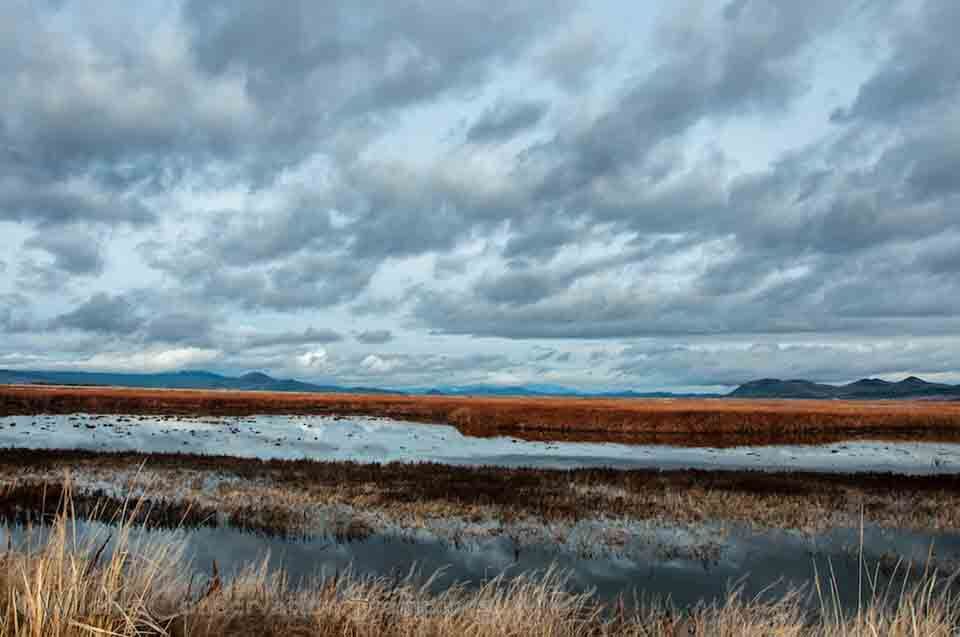Botulism And Bird Flu May be Causing Klamath Basin Wildlife Refuge Bird Deaths

KLAMATH COUNTY, Ore. — Refuge staff collected 500 dead birds from Sump1A, the largest water body in the Tule Lake National Wildlife Refuge in far Northern California.
The supervisory biologist at the Klamath Basin National Wildlife Refuge Complex, John Vradenburg, suspects a dual outbreak of botulism and highly pathogenic avian influenza are behind the birds dying as these were found in the refuges.
Thousands of birds are thought to have died in the Klamath Basin National Wildlife Refuge Complex this summer.
Bird Populations On Klamath Basin National Wildlife Refuge Complex
Spanning the Oregon-California border, the Klamath Basin National Wildlife Refuge Complex- comprising six wildlife refuges, is a crucial feeding and breeding ground for tens of thousands of birds that migrate through the Pacific Flyway. Ducks, geese, grebes, and shorebirds have been abundant this year partly due to a wet winter and aided by a larger water allocation by the Bureau of Reclamation.
The bureau diverted additional water to the refuges in spring to avoid unsafe conditions arising on the Klamath River while three dams were removed in Southern Oregon and far Northern California.
Vradenburg said that the current bird population is the highest and most diverse waterbird population on Tule Lake in three or four decades, with around 30,000 nesting grebes on Sump 1A, and 60,000 ducklings with 250,000 molting birds on Sump 1A and Sump 1B combined. These birds rely on water allocations from the Klamath Project but have received virtually none during recent droughts.
Following May’s water releases from Upper Klamath Lake the wetlands in the refuges began to warm and dry out and haven’t received more water leading to a higher risk of avian botulism outbreaks.
Avian Botulism
Caused by a toxin produced by a particular species of soil-dwelling bacteria the disease poisons birds as they ingest infected water, plant matter, fish, or invertebrates. Nerve damage, weakness, and paralysis are the result and birds often drown because they can’t hold their heads up. As other birds feed on other maggot-infested bird carcasses, the disease spreads further.
After the 2020 botulism outbreak- the worst in refuge history, luck, and creative management helped avoid another disaster despite the region still suffering a severe drought the following season.
Moss Driscoll, director of water policy for the Klamath Water Users Association (KWUA) said the key to preventing botulism “is not letting it get started.”
Refuge staff started finding dead and dying eared grebes last month and all the samples collected tested positive for highly pathogenic avian influenza, known as H5N1. The disease has ravaged wild and domestic birds globally and has spread to dairy cows in the U.S. Several cases of human infection have also been confirmed.
Outbreaks are less likely to occur in wetlands flooded with water circulating through them. The KWUA urged the Bureau of Reclamation in a July 12 letter to take action to prevent a disease outbreak in the refuges, but also increase water allocations to irrigators to save this year’s crop harvests.
While it’s now too late to prevent a botulism outbreak, the damage could be reduced. The Bird Alliance of Oregon (formerly Portland Audubon), California Waterfowl Association, and Ducks Unlimited have all called on the Bureau of Reclamation to divert water to the refuges immediately.
Active management and cooler temperatures could be helping to dampen the outbreak as refuge managers strategically dewater smaller wetlands to keep the largest one filled. Restoration work done during the drought is also helping water flow through parts of the Tule Lake Refuge, helping to keep botulism in check locally.
